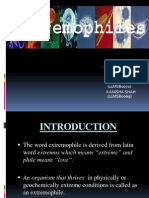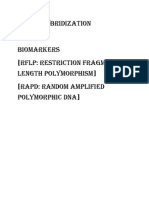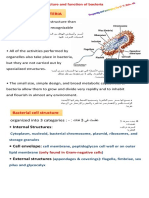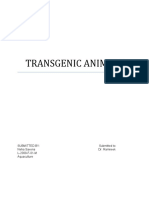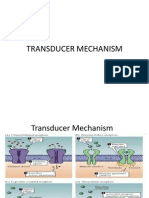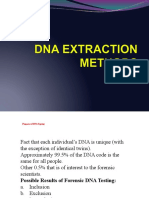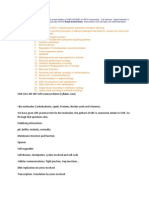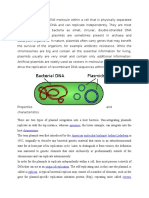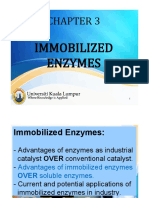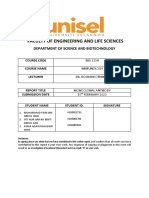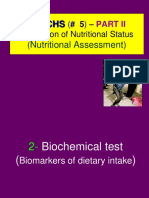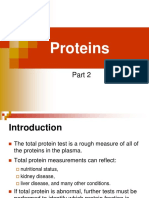0 ratings0% found this document useful (0 votes)
296 viewsMethods of Enzyme Purification
Methods of Enzyme Purification
Uploaded by
Dawlat SalamaThis document outlines several common methods for purifying enzymes, including salt precipitation, ion exchange chromatography, gel permeation chromatography, hydrophobic interaction chromatography, affinity chromatography, and immunoaffinity chromatography. It also describes methods for assessing purity, such as SDS polyacrylamide gel electrophoresis, and defines units of enzyme activity like specific activity, enrichment, and percent purity and recovery.
Copyright:
© All Rights Reserved
Available Formats
Download as DOC, PDF, TXT or read online from Scribd
Methods of Enzyme Purification
Methods of Enzyme Purification
Uploaded by
Dawlat Salama0 ratings0% found this document useful (0 votes)
296 views2 pagesThis document outlines several common methods for purifying enzymes, including salt precipitation, ion exchange chromatography, gel permeation chromatography, hydrophobic interaction chromatography, affinity chromatography, and immunoaffinity chromatography. It also describes methods for assessing purity, such as SDS polyacrylamide gel electrophoresis, and defines units of enzyme activity like specific activity, enrichment, and percent purity and recovery.
Original Description:
Enzyme
Copyright
© © All Rights Reserved
Available Formats
DOC, PDF, TXT or read online from Scribd
Share this document
Did you find this document useful?
Is this content inappropriate?
This document outlines several common methods for purifying enzymes, including salt precipitation, ion exchange chromatography, gel permeation chromatography, hydrophobic interaction chromatography, affinity chromatography, and immunoaffinity chromatography. It also describes methods for assessing purity, such as SDS polyacrylamide gel electrophoresis, and defines units of enzyme activity like specific activity, enrichment, and percent purity and recovery.
Copyright:
© All Rights Reserved
Available Formats
Download as DOC, PDF, TXT or read online from Scribd
Download as doc, pdf, or txt
0 ratings0% found this document useful (0 votes)
296 views2 pagesMethods of Enzyme Purification
Methods of Enzyme Purification
Uploaded by
Dawlat SalamaThis document outlines several common methods for purifying enzymes, including salt precipitation, ion exchange chromatography, gel permeation chromatography, hydrophobic interaction chromatography, affinity chromatography, and immunoaffinity chromatography. It also describes methods for assessing purity, such as SDS polyacrylamide gel electrophoresis, and defines units of enzyme activity like specific activity, enrichment, and percent purity and recovery.
Copyright:
© All Rights Reserved
Available Formats
Download as DOC, PDF, TXT or read online from Scribd
Download as doc, pdf, or txt
You are on page 1of 2
Methods of enzyme purification
1. salt precipitation
2. Chromatographic methods
i. ion exchange (cationic or anionic )
separation based on charge; the greater the net charge, the more strong
the interaction ; elute by increasing ionic strength of buffer or altering
pH
ii. gel permeation (size exclusion) chromatography:
separation based on size; larger proteins elute first
iii. Hydrophobic interaction chromatography:
separation based on hydrophobicity of protein surface; elute by
decreasing polarity of buffer ; more hydrophobic bind more strongly and
elute last.
iv. affinity chromatography:
separation based on specific biological interaction; eg enzyme –
substrate recognition; elute with substrate
v. immunoaffinity chromatography:
separation based on specificity of antibody recognition of peptide
sequence; elute by lowering pH to 2-3 to disrupt antibody – peptide
interaction. Neutralize quickly to avoid loss of activity.
Assessment of purity
SDS polyacrylamide gel electrophoresis
enrichment
N-group analysis
Units of enzyme activity
Activity: amount of product produced per unit time (eg. ?mols /
sec)
Specific activity: amount of product produced per unit time per mg
protein
(eg. mmols / sec / mg)
Enrichment: SA of fraction / SA of starting material
Maximum possible enrichment: 100 / % of total protein
represented by protein of interest
% purity : actual enrichment / maximum possible enrichment
% recovery (yield) : total activity of fraction / total starting
activity
You might also like
- Enzyme AssaysDocument3 pagesEnzyme AssaysAudreySlitNo ratings yet
- Chapter 25 Fluid, Electrolyte, and Acid-Base BalanceDocument5 pagesChapter 25 Fluid, Electrolyte, and Acid-Base BalanceDawlat SalamaNo ratings yet
- BIOL 3301 - Genetics Ch10B - Chromosome Structure STDocument45 pagesBIOL 3301 - Genetics Ch10B - Chromosome Structure STChuongNo ratings yet
- Isolation, Purification, and Characterization of Serratiopeptidase Enzyme From Serratia MarcescensDocument6 pagesIsolation, Purification, and Characterization of Serratiopeptidase Enzyme From Serratia MarcescensInternational Journal of Innovative Science and Research TechnologyNo ratings yet
- Applications of Enzyme ImmobilizationDocument15 pagesApplications of Enzyme Immobilizationamrita_azam92% (13)
- Applications of Technology Molecular Markers in Aquaculture GeneticsDocument29 pagesApplications of Technology Molecular Markers in Aquaculture Geneticsrobi binur100% (2)
- ExtremophilesDocument36 pagesExtremophilesAdnan QureshiNo ratings yet
- Ultra Centri Fug at I OnDocument9 pagesUltra Centri Fug at I OnMuhammad BilalNo ratings yet
- BiochemistryDocument5 pagesBiochemistryAngeline LimpiadaNo ratings yet
- Applications of Animal Cell CultureDocument6 pagesApplications of Animal Cell Culturelalin271100% (1)
- Eukaryotic Dna Replication PDFDocument2 pagesEukaryotic Dna Replication PDFHughNo ratings yet
- Sutherland 1991Document7 pagesSutherland 1991Isal AbdussalamNo ratings yet
- Cancer Immune TherapyDocument452 pagesCancer Immune TherapyatyNo ratings yet
- Restriction Enzymes MSC BiotechDocument37 pagesRestriction Enzymes MSC BiotechRoneet Ghosh0% (1)
- In-Situ Hybridization & Biomarkers (RFLP: Restriction Fragment Length Polymorphism) (Rapd: Random Amplified Polymorphic Dna)Document17 pagesIn-Situ Hybridization & Biomarkers (RFLP: Restriction Fragment Length Polymorphism) (Rapd: Random Amplified Polymorphic Dna)Miley KrisNo ratings yet
- Digital PCR - A Sensitive and Precise Method For KIT D816V Quantification in MastocytosisDocument9 pagesDigital PCR - A Sensitive and Precise Method For KIT D816V Quantification in MastocytosisMagan AliNo ratings yet
- Types of BiotechnologyDocument3 pagesTypes of BiotechnologyMarini Hernandez33% (6)
- La2 Structure and Function With Growth of BacteriaDocument10 pagesLa2 Structure and Function With Growth of BacteriaRihan RihanNo ratings yet
- 1.1.5 ElisaDocument24 pages1.1.5 Elisadaisy ibuokaNo ratings yet
- Bacterial Optical Density MeasurementsDocument4 pagesBacterial Optical Density Measurementskrishnarao2010No ratings yet
- Source: Tortora 13 Edition Source: Tortora 13 Edition: TH THDocument20 pagesSource: Tortora 13 Edition Source: Tortora 13 Edition: TH THAastha BaradiyaNo ratings yet
- 1 Cells of The Immune SystemDocument90 pages1 Cells of The Immune Systemmark njeru ngigiNo ratings yet
- Transgenic Animal Production and ApplicationsDocument7 pagesTransgenic Animal Production and Applicationsj cNo ratings yet
- Directed Mutagenesis and Protein EngineeringDocument52 pagesDirected Mutagenesis and Protein Engineeringslowdragon2003100% (1)
- Gene SilencingDocument18 pagesGene SilencingNAMRA RASHEEDNo ratings yet
- Prepared By: Verna Jean M. Magdayao 3/Bsbiology/ADocument56 pagesPrepared By: Verna Jean M. Magdayao 3/Bsbiology/AKathleya PeñaNo ratings yet
- Lec04 MicroDocument13 pagesLec04 MicroMayurdhvajsinh JadejaNo ratings yet
- Specific Host Defenses: The Immune ResponseDocument54 pagesSpecific Host Defenses: The Immune Responseadyaly44No ratings yet
- Chromatin RemodelingDocument5 pagesChromatin RemodelingRohit GargNo ratings yet
- Protein PurificationDocument23 pagesProtein PurificationShashikant GatkalNo ratings yet
- Restriction EnzymeDocument6 pagesRestriction EnzymeFelix SimsungNo ratings yet
- lectut-BTN-303-pdf-Protoplast Technology PDFDocument12 pageslectut-BTN-303-pdf-Protoplast Technology PDFqwertNo ratings yet
- Animal Cell Culture - Part 1Document38 pagesAnimal Cell Culture - Part 1Subhi MishraNo ratings yet
- TRANSGENIC ANIMALS PDocument12 pagesTRANSGENIC ANIMALS PNehaNo ratings yet
- Characteristics and Genotyping (Semi-Automated and Automated), Apparatus Used in GenotypingDocument45 pagesCharacteristics and Genotyping (Semi-Automated and Automated), Apparatus Used in GenotypingKhalid HameedNo ratings yet
- 5.1 Blotting TechniquesDocument33 pages5.1 Blotting TechniquesAmir Al-Aiman100% (1)
- EnzymologyDocument47 pagesEnzymologyTererai Lalelani Masikati Hove100% (1)
- Subcellular Fractionation Methods and StrategiesDocument22 pagesSubcellular Fractionation Methods and StrategiesDaniel Juarez SerranoNo ratings yet
- Omics IntroductionDocument25 pagesOmics IntroductionMarlvin PrimeNo ratings yet
- Organization of DNADocument31 pagesOrganization of DNAoyehello23No ratings yet
- Restriction EnzymesDocument9 pagesRestriction EnzymesskmfscNo ratings yet
- Transcriptomics: Shivangi Asthana B.Sc. BiotechDocument22 pagesTranscriptomics: Shivangi Asthana B.Sc. Biotechsachin kumarNo ratings yet
- Transducer MechanismDocument10 pagesTransducer MechanismcaishamNo ratings yet
- FACSDocument8 pagesFACSKarthick ThiyagarajanNo ratings yet
- Sequecing - Khan AcademyDocument16 pagesSequecing - Khan AcademyMaryem SafdarNo ratings yet
- Dna Extraction MethodsDocument63 pagesDna Extraction MethodsSimranNo ratings yet
- ImmunoglobulinDocument39 pagesImmunoglobulinReguird AllaeinniNo ratings yet
- Csir Life Sciences Fresh Instant NotesDocument4 pagesCsir Life Sciences Fresh Instant NotesAlps Ana33% (3)
- Gene TransferDocument11 pagesGene Transferseeyo123No ratings yet
- Virus NotesDocument6 pagesVirus NotesHuiqing TeoNo ratings yet
- Transgenic Animals: Their Benefits To Human Welfare: What Is A Transgenic Animal?Document7 pagesTransgenic Animals: Their Benefits To Human Welfare: What Is A Transgenic Animal?anon_939844203No ratings yet
- Western BlottingDocument13 pagesWestern BlottingAshfaq Fazal100% (1)
- A Plasmid Is A Small DNA Molecule Within A Cell That Is Physically Separated From A Chromosomal DNA and Can Replicate IndependentlyDocument5 pagesA Plasmid Is A Small DNA Molecule Within A Cell That Is Physically Separated From A Chromosomal DNA and Can Replicate Independentlyyaqoob008No ratings yet
- Chapter 3 (Immobilized Enzyme)Document28 pagesChapter 3 (Immobilized Enzyme)abdqayumNo ratings yet
- Diagnosis of TrypanosomiasisDocument82 pagesDiagnosis of TrypanosomiasisDrVijayata Choudhary100% (1)
- Mini PrepDocument6 pagesMini PrepWilson GomargaNo ratings yet
- Module-1: Genomics and Proteomics NotesDocument8 pagesModule-1: Genomics and Proteomics NotesNishtha KhannaNo ratings yet
- Monoclonal Antibody ReportDocument9 pagesMonoclonal Antibody ReportAsma Adawiyah IdrisNo ratings yet
- TM-04 Prokaryotic and Eukaryotic Chromosome Structure (Genap 2016-2017)Document32 pagesTM-04 Prokaryotic and Eukaryotic Chromosome Structure (Genap 2016-2017)Fiy Jannatin AliyahNo ratings yet
- C Value ParadoxDocument4 pagesC Value ParadoxEr Purushottam PalNo ratings yet
- AACR 2016: Abstracts 1-2696From EverandAACR 2016: Abstracts 1-2696No ratings yet
- 5 Evaluation of Nutritional Status - Nutritional Assessment - PART IIDocument10 pages5 Evaluation of Nutritional Status - Nutritional Assessment - PART IIDawlat SalamaNo ratings yet
- Industrial Applications of EnzymesDocument4 pagesIndustrial Applications of EnzymesDawlat SalamaNo ratings yet
- Uoh Genetic Lesson01 Activity1 Assessmentas v2 Tedl DWCDocument1 pageUoh Genetic Lesson01 Activity1 Assessmentas v2 Tedl DWCDawlat SalamaNo ratings yet
- Chemistry Biology Exam 2 With Solution PDFDocument26 pagesChemistry Biology Exam 2 With Solution PDFDawlat SalamaNo ratings yet
- Water Homeostasis: Benjamin/Cummings Publishing CoDocument11 pagesWater Homeostasis: Benjamin/Cummings Publishing CoDawlat SalamaNo ratings yet
- Techniques To Separate Amino Acids and ProteinsDocument38 pagesTechniques To Separate Amino Acids and ProteinsDawlat SalamaNo ratings yet
- Phyto EstrogenDocument8 pagesPhyto EstrogenDawlat SalamaNo ratings yet
- Radio Immuno As SayDocument35 pagesRadio Immuno As SayDawlat SalamaNo ratings yet
- 6 Mcq2 Enzymes 130107225709 Phpapp02Document14 pages6 Mcq2 Enzymes 130107225709 Phpapp02Dawlat SalamaNo ratings yet
- Lab Methods For Total ProteinDocument36 pagesLab Methods For Total ProteinDawlat Salama100% (1)
- The Basic Quality Control StatisticsDocument24 pagesThe Basic Quality Control StatisticsDawlat Salama100% (1)
- Lecture On Serological Diagnosis of Infectious Diseases andDocument165 pagesLecture On Serological Diagnosis of Infectious Diseases andDawlat SalamaNo ratings yet






